Collagen is currently one of the most popular dietary supplements. The promise: improved cartilage, tendon, and joint health – a fact important for every athlete, regardless of their sport. Therefore, it is worthwhile to take a closer look at the mechanism and the general scientific evidence for the effectiveness of collagen in pain relief and joint health.
Background
In 2019, an estimated 57 million people in Western Europe suffered from osteoarthritis, a condition in which articular cartilage wears away, exposing the underlying bone, often causing chronic pain and requiring surgical treatment (
1
). In athletes, connective tissue injuries are the most commonly reported type of injury. It is therefore not surprising that there is great interest in finding strategies that can lead to better soft tissue quality and/or support the healing properties of cartilage, tendons, and ligaments. In this context, collagen is of great interest as it structurally supports the extracellular space of connective tissue. Collagen is the most abundant protein in connective tissue, specifically collagen, and particularly type I collagen. The strength and stiffness of our connective tissue and tendons are therefore partly determined by the amount of collagen they contain. Therefore, it is plausible that an improvement in collagen synthesis can indirectly lead to better quality of joints and connective tissue and reduce the risk of injury (
2
).
This Article Analyzes and Summarizes the Effectiveness of Collagen Supplementation on Joint and Tendon Health.
Collagen is a protein structure composed of amino acids. Unlike muscle tissue, it contains fewer essential amino acids and more proline and glycine. 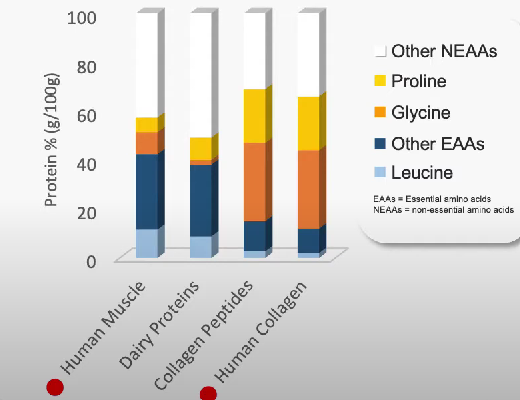
This leads to the hypothesis that the intake of certain nutrients containing high amounts of proline and glycine could potentially exert an anabolic stimulus on the rate of collagen synthesis. Two nutrients of interest that meet this criterion are collagen-derived dietary protein sources, such as gelatin and collagen hydrolysate.
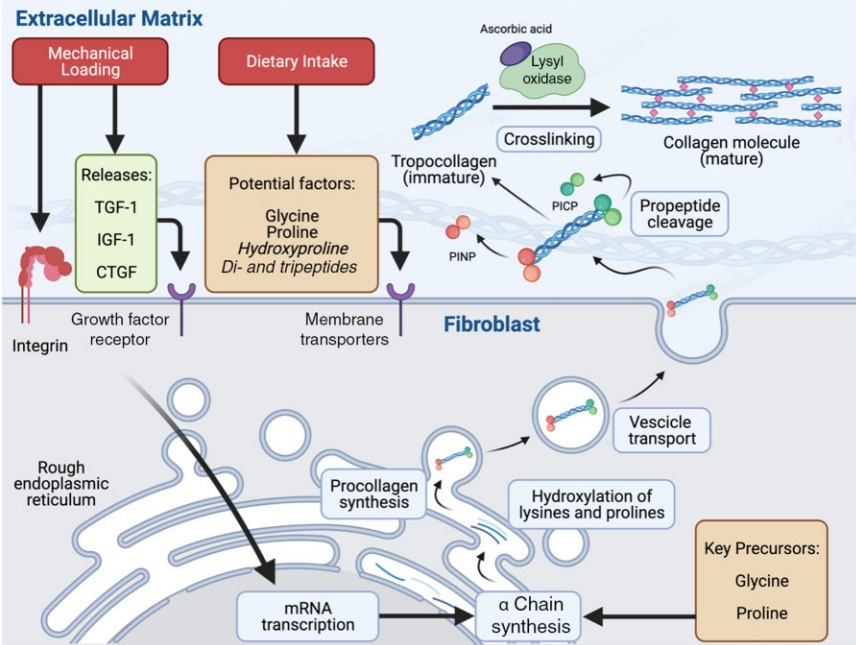
Simplified representation of collagen metabolism (
3
)
But Don’t Gelatin and Collagen Have Poor Protein Quality?
It is true that gelatin and collagen tend to have rather low-quality properties for a protein – at least when using biological value to assess protein quality. However, one must consider what biological value actually aims to do – and that is to compare the amino acid composition of foods with the amino acid matrix of human muscle (
4
). So yes, gelatin and collagen are not well-suited candidates for maximizing muscle growth: indeed, new studies have found no positive effect of collagen supplementation on muscle protein synthesis (
5
). However, this does not automatically mean that they cannot have positive effects on other tissues.
How Well are Gelatin and Collagen Absorbed?
An early mechanistic study from 1999 found that gelatin hydrolysate is indeed absorbed by mice and leads to an accumulation of gelatin hydrolysate in cartilage tissue (
6
). Almost two decades later, researchers were able to confirm these observations in humans (
7
). In a cross-over study, 8 healthy subjects consumed either 0, 5, or 15 g of gelatin enriched with 48 mg of vitamin C sixty minutes before a 6-minute jump rope session.
The Results:
The intake of 15 g of vitamin C-enriched gelatin led to a significant increase in blood glycine and proline concentrations, demonstrating that these “low-quality” proteins are indeed absorbed and lead to a significant increase in the amino acids glycine and proline, which play an important role in the process of collagen synthesis.
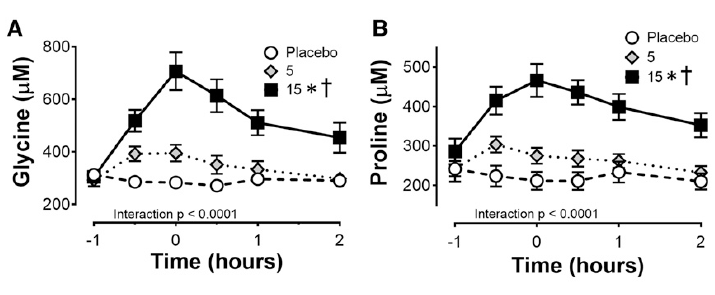
Glycine and proline concentrations in the blood after consuming 0, 5 or 15g of Gelatine – Vitamin-C enriched (
7
)
More importantly, a significant positive effect on the collagen synthesis rate was measured (PINP): The amino-terminal propeptide (PINP) is a precursor of collagen and contains a short signal sequence and terminal extension peptides.
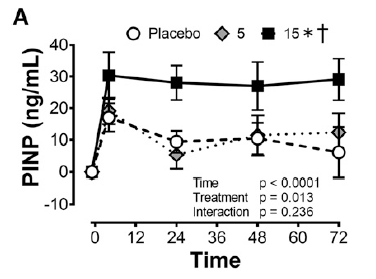
Collagen synthesis rate measured via PINP, with 0, 5 and 15g of Gelatine – Vitamin-C enriched (7)
And What about Collagen as a Supplement?
The same research group conducted a follow-up study comparing the effect of 15 g of hydrolyzed collagen with 15 g of gelatin (enriched with vitamin C) and gummy bears containing both gelatin and collagen (
8
).
The Results
Both collagen and gelatin (enriched with vitamin C) supplementation led to an increase in collagen synthesis rate of approximately 20%, which was, however, not statistically significant. A closer look at individual participants also reveals a large individual variance: upon closer examination of the individual data, the overall positive effect appears likely to be due to a positive outlier – in both the gelatin and collagen groups. In fact, no positive change in collagen synthesis rate was measured in 3 of the 8 participants in the gelatin group, and no effect was observed in 4 of the 8 participants in the gelatin group. 
Therefore, it is Questionable whether these Positive Findings Can be Generalized to the Broader Population….
Furthermore, it is worth noting that the researchers used an artificial ligament in both studies. Indeed, there are currently no human studies that confirm these results in humans, which is also not methodologically possible at present. Given these two circumstances, in my opinion, we need further studies with larger cohorts to confirm these results before we can say with certainty that gelatin/collagen supplementation has a positive influence on collagen synthesis. However, there are further studies we can look at to better assess the overall effect on joint and ligament health. For example, McLindon and colleagues (
9
) investigated the effect of daily supplementation of 10 g of collagen hydrolysate on mild knee osteoarthritis over a period of 48 weeks. The long study duration is definitely a major plus. The researchers also assessed cartilage function using dGEMRIC images, which is a much better indicator of changes in cartilage tissue than measuring the acute synthesis rate over a short period (
10
,
11
). And indeed, a positive effect is clearly visible when looking at the following images:
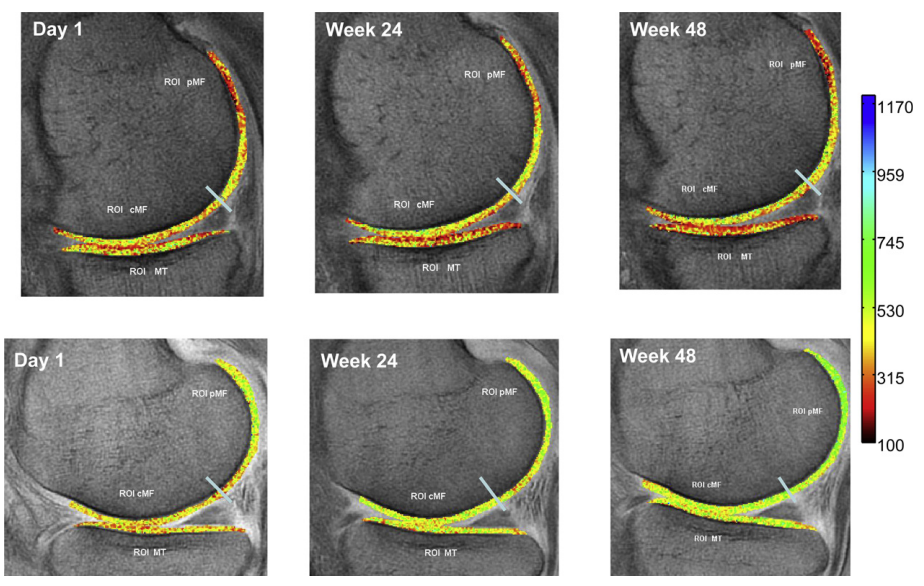
the bottom photo series is from the collagen group, where more green indicates more cartilage mass
Is this Proof that Collagen Supplementation is Actually Effective in Improving Cartilage Damage?
Caution, Details are Important!
The dGEMRIC images used showed improvements in cartilage in the posterior lateral femoral region, with the collagen group exhibiting a statistically better improvement than the control group. However, further MRI scans of cartilage tissue in other regions (medial tibia, central mid-femur, posterior medial femur, lateral tibia, central lateral femur) showed no differences between the collagen and placebo groups. This could, for example, be attributed to less movement/activation of these joints. However, this is difficult to assess without further information on the training. The author’s conclusion was therefore:
In contrast to the dGEMRIC results, T2 cartilage measurements showed little variability or change over time and no differences in any region between the groups […] due to the pilot nature of this study and its small sample size, we do not consider these results definitive, and the CH intervention warrants further testing in a larger study.
Ultimately, it remains unclear why the collagen group showed improvement in certain areas and no change in others. With only 15 participants per group, the sample size of this study is too small to draw definitive conclusions, and unfortunately, there are no other studies that use dGEMRIC images to evaluate changes in cartilage structure.
Collagen: Influence on the Stiffness and Functionality of Tendons and Ligaments
In the same study (
9
), possible changes in physical functionality and stiffness were also investigated, but no positive effect of collagen supplementation could be found. However, it should be noted that the participants did not undergo a systematic training program to strengthen muscles, tendons, or other soft tissues. This could explain why McAlindon et al. 2011 (
9
) found no positive effect, as resistance training is a necessary stimulus for collagen synthesis (
12
). In another study, Leet et al. (2003) found a small benefit of daily supplementation of 30 g of collagen hydrosylate (+ 500 mg vitamin C) on patellar tendon stiffness in female soccer players [COL, +18.0 ± 12.2% (d = 1.11) vs. PLA, +5.1 ± 10.4% (d = 0.23), p = 0.049]. However, tendon growth was similar between groups (
13
). In another study, 40 healthy young men trained their calf muscle and Achilles tendon for 14 weeks, 3 training sessions per week, and consumed 5 g of collagen peptides (CP – Temdeforte®) (
14
). To my knowledge, this is the only study where participants followed a structured resistance training protocol for more than 3 months, with training weight gradually increased. Perhaps this is why the authors were able to observe a significantly (p = 0.002) greater increase in tendon growth (CSA +11.0%) compared to the PLA group (+4.7%). In contrast, there was no difference in tendon stiffness or muscle strength, which increased between the groups. Praes et al. (2019) used a similar supplementation protocol: In a double-blind RCT with a cross-over design, 10 participants with Achilles tendinopathy consumed 2.5 g of CP over a period of 6 months in combination with a twice-daily calf strengthening program (
15
). They also found no benefit of CP on tendon microvascularity, which was examined using contrast-enhanced ultrasound (CEUS). CP supplementation also had no effect on ankle functionality and tendon pain, which were assessed using the VISA-A questionnaire. Furthermore, a positive trend towards a faster return to sport was observed in athletes taking CP. However, too few subjects participated in the study to perform a statistical analysis. In other words, we do not know whether the observed differences are due to chance or whether they are actually the result of CP intake. Interestingly, this study is often cited and used as a reference for the effectiveness of CP supplementation, even though it shows no statistically significant effect.
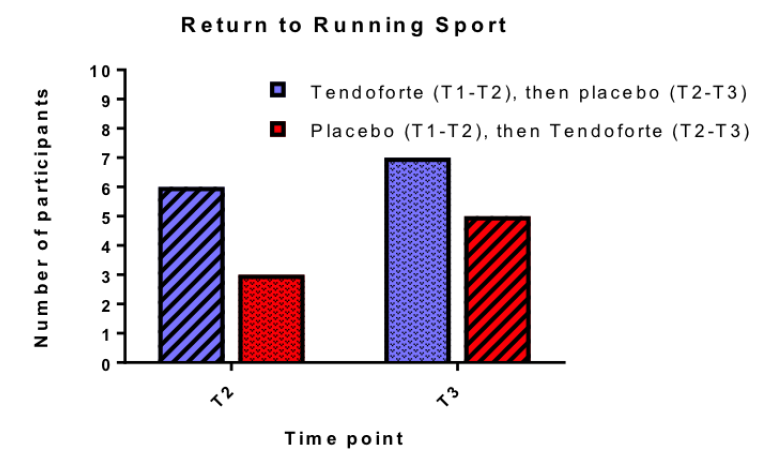
Praet et al., (2019): no statistical analysis due to the small number of subjects
Pain-Relieving Effect?
Several studies were indeed able to observe a reduction in pain perception due to arthritis (16,17,18). An improvement was noted not only in the patients’ subjective pain perception but was also confirmed by a physician’s measurements and tests. Depending on the study, pain perception improved by 10-25%.
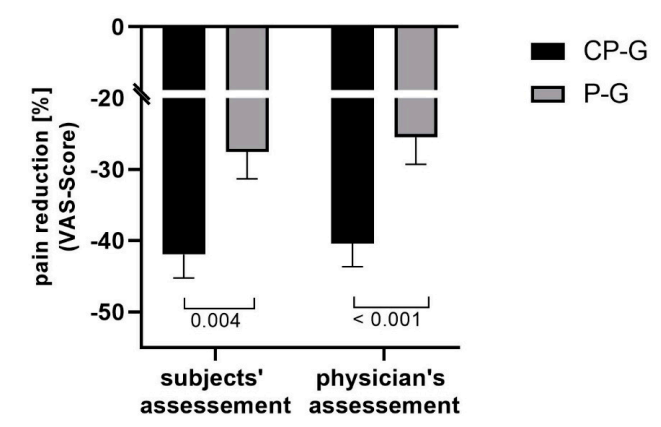
Relative change in subjective pain perception (VAS Score)
(16)
However, it should also be mentioned that there are studies that could not find any improvement. (
19
).
Recommend Collagen for Pain: Yes or No?
A 10% pain reduction is not particularly significant. A 25% reduction in perceived pain, however, is quite a decent improvement. Ultimately, one does not know which category they fall into until they have tried it for several weeks. That is to say: anyone suffering from chronic pain due to cartilage damage should simply try collagen for 8 weeks in combination with a rehabilitation program and see if a positive effect can be observed.
Positive Effect of Whey and Casein?
It is reasonable to assume that high-quality protein sources such as whey or casein protein most likely have a positive effect on collagen synthesis. Surprisingly, however, this does not seem to be the case. In several studies using whey protein, no positive effect on intramuscular connective tissue or collagen synthesis rate could be observed (
20
,
21
). One hypothesis as to why no effect on connective tissue synthesis was found in these studies is that whey protein is generally metabolized “too quickly” and that the activation of connective tissue occurs with a delay, thus requiring a more slowly absorbed protein to be optimally stimulated.
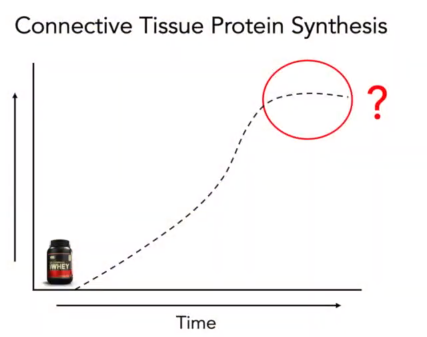
Source: Nutrition Tactics
This hypothesis was investigated by Trommelen et al. (2020): While they found that exercise itself activates the connective tissue synthesis rate, no additional benefit was observed when 30 g of casein protein was consumed after endurance training (
22
). Connective tissue proteins contain high concentrations of proline (12%) and glycine (25%) compared to other proteins in skeletal muscle. Casein, however, contains only small amounts of proline (6.5%) and glycine (2%) and therefore cannot provide enough of these important amino acids to increase the protein synthesis rate of connective tissue after exercise (
23
). This hypothesis is supported by the fact that the casein administered by Trommelen et al. (2020) did not increase blood glycine concentration.
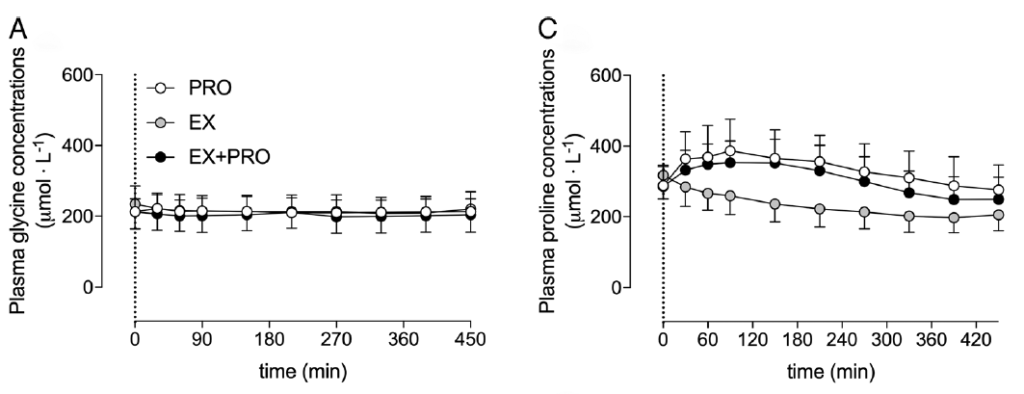
Changes in blood glycine and proline concentrations after intake of 30g of casein (Trommelen et al., 2020)
What Happens with Higher Protein Amounts?
This question was investigated in a follow-up study by the same researchers (24): In this study, older subjects consumed 40g of casein after resistance training.
we show for the first time that amino acids from dietary proteins are incorporated into new cartilage tissue in older adults
And Indeed, a Positive Effect on the Synthesis Rate of Cartilage Tissue Was Observed.
However, a possible effect on collagen synthesis was not measured here. And unfortunately, due to the study design, we cannot specifically deduce whether the positive effect was caused by exercise and casein supplementation.
Summary:
- Mechanistic in vitro studies show that collagen and gelatin could have a significant positive influence on cartilage synthesis rates.
- In patients with chronic joint pain, continuous collagen supplementation for 8 weeks or longer can improve subjective pain levels by ~10 to 25%.
- Currently, the evidence for improving cartilage health is rather weak.
- The effectiveness of collagen on tendon stiffness appears to be somewhat better. Whether this truly prevents injuries or reduces recovery time is still unclear.
- It appears that both whey and casein protein have no significant effect on cartilage tissue, even when consumed in larger quantities.
- We still lack high-quality human RCTs to draw definitive conclusions about the potential positive effects of collagen supplementation on joint and tendon health.
Our Assessment
Evidence for improving the health of cartilage, tendons, and ligaments  Overall, the research landscape is very mixed; some studies show promising results. However, looking at the details of these studies, almost all of them have methodological weaknesses. The results of mechanistic studies, as well as the positive results regarding pain reduction, are somewhat promising. However, we need more high-quality RCTs with humans to draw more definitive conclusions. As of: February 2024
Overall, the research landscape is very mixed; some studies show promising results. However, looking at the details of these studies, almost all of them have methodological weaknesses. The results of mechanistic studies, as well as the positive results regarding pain reduction, are somewhat promising. However, we need more high-quality RCTs with humans to draw more definitive conclusions. As of: February 2024
